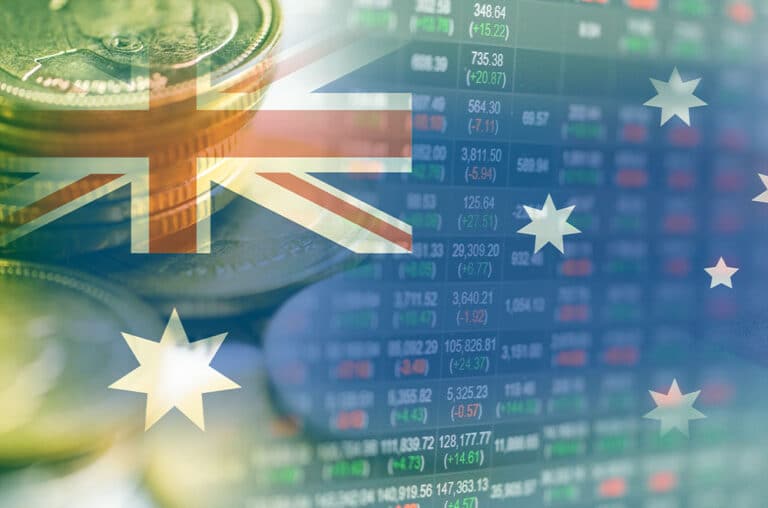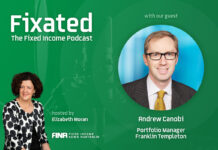
Elizabeth Moran sits down to talk with Markus Mueller, Co-Founder of The Australian Bond Exchange. Before co-founding ABE, Markus was Director/Branch Manager at Morgans/Reynolds, and before that was a Director of Reynolds Stockbrokers. He worked previously in private banking, fixed income and currencies in the United Kingdom and Switzerland.
How long have you been working in fixed income?

Well, I started my career in UBS in Switzerland. Fixed interest was really one of the main games, if you looked at client portfolios in Europe back then. So, I’ve been involved in finance for a long time. In the late ’80s I was trading fixed interest very actively. While working in London, we did a lot of Eurodollar bonds, and a lot of different currencies. We did Swiss Francs, Pounds, Escudos, and French Francs, and whatever else was out there.
I remember back in ’92 when we had a major currency crisis, (George Soros cracked the bank of England,) and we had major bond holdings all over Europe, but we couldn’t sell them anymore, the markets froze. Spreads blew out and the markets really fell apart, and that’s when overnight interest rates exploded, I think it was in Sweden, they went up to 80 or 90%.
So I’ve been in bonds for quite a while, and then I migrated to Australia in the early ’90s and fell into stock broking. For almost 25 years I was really in stockbroking, and as you know, fixed interest really has been a bit forgotten in Australia. When I used to talk with my older friends in the stockbroking world who saw the ’60s and the ’70s, fixed income used to be very popular. Ordinary investors where very active in the ’60s and the ’70s in bonds, and somehow the asset class got a bit forgotten in Australia.
As you can see, I have been trading bonds in the major trading financial centres in London, Geneva and in Zurich and also traded a lot of convertible notes and also Japanese warrants back then. That was in the early ’90s.
A long time, and what led you to start, co-found ABX?
I’ve known Brad McCosker since the ’90s and then when he came back from New York in 2011 we would say, “This whole fixed interest situation in Australia really is something where we could make a difference and maybe there’s a market niche”. The established players have done a great job, but we think the potential in Australian for fixed interest is still enormous.
If you look the amount of savings we’ve got in Australia now and compare how small the exposure to fixed interest is, you can see how huge the opportunity still is to promote fixed interest to ordinary investors. We started the journey back in 2016 when Brad got the license and we started to build the business. Here we are, five years later, time flies.
Time sure does fly when you’re having fun. So, Markus, you trade now, what does a sort of a normal day look like for you?
I think for any trader or any market participant, a big portion of their day is just information gathering. So, I think anybody involved in the market does a lot of reading. A lot of talking with competitors, talking with clients, talking with counterparties, talking with my overseas contacts as well. Being an old-stock broker, the bonds we trade are often issued by companies that are usually listed on the ASX, which makes it easier for us and the investors to follow the progress of the companies. But that’s really it, and then of course you have a lot of economic news and central banks doing various things which makes it very fascinating and exciting.
At the moment we have this really big yield adjustment in government bond yields worldwide, yields have been lifting quite dramatically, and you may recall that earlier in the year, our 10 year government bond rates went close 2%, and then they came back down to a low of about 1.1%, and now we’re almost back up to circa 1.6%, so there’s quite a bit of volatility in the government bond space, which is challenging for everybody involved.
Great for traders though, I imagine, because you have the opportunity to make money?
I’m currently mainly buying corporate bonds and we’re not promoting trading for our mum and dad clients. For a normal investor fixed income is really a saving sanity and should provide them with reliable income streams and very little volatility. We’re currently not running principal positions, and I don’t do futures, or anything of that sort. We have recently established an office in Singapore with Nick Barber and he’s going to further expand our footprint in the Asian markets for us, so that could change slightly.
Interest rates are really low at the moment, and margins are really compressed across all the asset classes. Have you seen them this low before, and what do you think’s the path out, or do you think we’re in low for longer, longer, and longer?
That’s a tough question Liz. Look, we have had low interest rates in Europe for 10 years now and it looks like they are ready to move back up slightly. We’ve had negative interest rates for almost 10 years in Switzerland and ordinary savers get charged interest from the Swiss banks to hold their money. So, low interest rates are not completely new to me, but as I said, we are speaking of something we’ve never seen before here in Australia.
That’s new for everybody, and that’s a whole new ball game for people with money. Where do you put your money? That’s a real challenge and it’s not going to go away. However, there are much more competent people who are commenting on this situation, like your interview the other day with Warren Hogan which was fantastic, and I recommend everybody listen to that podcast, because it gave everybody a fantastic roadmap.
I feel, with the Reserve Bank, that it’s now not so much about monetary policy and interest rates, it’s more about fiscal policy and tax and regulation. We just saw this recently with APRA’s intervention into the housing market, where they manipulate the banking system to achieve their goals instead of interest rates.
We don’t feel that you’re going to see much change in the short end of the curve. Market expectation is that cash rates should peak probably around 1-1.5% in this cycle. But look, at the end of the day, we are all in a new territory, globally. Nobody really quite knows. We are all guessing to a certain degree, and there’s a lot of conflicting messages. It’s currently impossible to invest your money without taking risks, with these zero percent rates worldwide, investors are forced to take risks, that’s the picture.
So just thinking about the government bond rates, our 10 year yield coming back up to 1.6%, do you think that’s the start of a correction? Or… I mean, it’s been so volatile. It could easily come off again, couldn’t it? The yield. It’s hard to predict, as you say, but do you have any thoughts on that?
That’s the challenging bit. Look, my gut feeling is that it probably went too low, because the global economy really has the potential to start to pick up quite substantially over the next two or three years. For example, my old chief economist, Michael Knox, from Morgans has a very bullish view. I think government bond yields on the long end were maybe a bit too low, and they are really just adjusting.
The problem is you have these spikes in the bond and the equity market as well. These spikes, up and down in prices, which makes it a bit confusing. It creates huge opportunities if you’re a trader. So, I think it can go a bit higher, but I don’t think the 10year government bond rate will suddenly go to 2.5-3%, I don’t think it quite makes sense. But it’s a tough one.
So now, if I’m wanting to buy bonds, I’m just wondering what sort of spreads are available on the different credit ratings. If I was looking for a single A credit investment, right down through to flat B, what sort of margins or yields can I expect
Look, anything to do with quality, government bonds, single A’s, as a private investor, they’re really not worthwhile, returns are so low. You’re almost better off staying in term deposits earning 1% or even less. In highly rated bonds you have to go a long way out on the curve, and then you’re taking huge interest rate risk, which just doesn’t make sense. If you go into triple B’s, you might earn 2.5-3%, then upwards of 3.5%, for sub investment grade. For my liking, I don’t like to go out too far down the credit rating spectrum because then you are subjected to quite a bit of price volatility.
For personal investors the magic number is 4% plus. That seems to be in everybody’s mind still. That’s what they’re trying to achieve, and we still find this. I think you definitely need to look a bit harder, especially in the high yield space. We definitely see a lot of demand at the moment in property deals. Of course, you need to do your credit risk assessment, because you’re lending money to a quasi-bank as sort of a non-bank lender, who lends it to the riskier side of the building game. So, you need to go back and do your homework. If you want to get a half decent return, you’re forced to take a bit of risk, unfortunately, but still in the big picture of risks, a bond risk is still way, way lower than equity or property. Direct property anyway.
Absolutely. So, I know the Australian bond exchange has been busy with its fractionalisation system and getting individual bonds up on trading platforms, such as IRESS, how’s it been going?
It’s going quite well. With an IT product, there’s always the nitty gritty details to the connectivity’s and the back office to work out, so we are working through the issues, but, stockbrokers can sign up and trade via their existing IRESS terminals and which connects them to our system. They can buy OTC bonds via the existing infrastructure, and we can help them with the whole range, from settlement to the research, custody, and fractionalisation as well. Most bonds, we can fractionalise down to $10,000 per issue. Depends a bit on the bond. It’s going really well, thank you.
I think it’s a great way for investors, particularly if you have a SMSF and you want the reporting together, you can just buy through the IRESS platform and all your investments are together. They’re easier to manage, so I think that’s a really great initiative.
Earlier on in the year, you guys did a bond for Pallas Capital, and I’m just wondering how’s that performed, and roughly where is it trading now, and what sort of experience have investors had?
Yeah, that’s been going really well. I think total money raised is getting close to $70 million. They’re due to report the next quarterly report to bond holders. They invested all the money raised into various different projects. Investors would have received three coupons by now. The price is about $101.50, so it’s trading at a yield to maturity of around 7%, and the Pallas guys are going from strength to strength. I think their total loan book is over a billion dollars now. They also do a lot of single asset deals. Investors who want to take bigger risks can go to their website and invest into some of their products direct, which maybe gives them an even a higher yield, and of course this comes with higher risk as well.
What I like in the Pallas bond is, first of all, you can actually sell the bond if you need money. Most people never sell the bonds, but it’s an option. The other positive feature is you don’t have a single property exposure, so you’re well diversified. They usually invest in, between 10 and 15 deals, and there are all the protection mechanisms from the bond covenants. So, it makes me feel very comfortable even with the very high yield. Obviously, the high yield alerts investors to the higher risk, but I can quantify the risk, and I’m quite happy to take it. The Palace team has been fantastic, from strength to strength.
Excellent
The property market has been good as well. We need to say this as well. I mean, property has gone from strength to strength, so that definitely helps.
Great, are there any other new issues you’d like to let our readers know about
Yes, you may recall in June, July, we issued the Jaguar credit note, and that’s gone really well. We actually decided to do a top up. So, initially we raised $12 million first round, and are just doing another round, raising another $8 million to make a total of $20 million. We found this is one of the best yielding, quality companies out there, that we could find globally. Investors can participate in a global brand name, and don’t have any currency exposures. Currency fluctuations are hedged away. Your underlying risk is Jaguar Land Rover. The bonds pay a 4.5% fixed coupon and matures in November 2026. If any of your readers would like to participate in the top up, it’s still open until the 19 October, they can contact us via the website, or send an email.
We did the bond via Singapore counterparties because Europeans, and Asian investors, are used to these types of structures. They have been very impressed that we got this away in Australia. I think this is the way forward, especially if you look at Europe and the European retail bond market. We probably have to go down this track to find the yields and quality investors want.
Okay, that’s really interesting. Is it $10,000 minimum to invest in that Jaguar bond?
It’s $10,000 minimum. It’s open to retail and wholesale.
The Pallas Capital bonds is only available to wholesale investors at this stage until December, but we were able to structure the Jaguar Land Rover securities and make them available to retail investors.
The Jaguar Land Rover coupon gets paid twice a year direct into bank accounts. It’s a fixed coupon, and again, we’re making markets, so if clients really want to sell the bonds before maturity, it’s possible.
Fantastic Markus. I think we’re at the end, unless there’s anything you want to add?
Yes. I would like to add something, Liz, because I want to say thank you for your great work. So your platform is definitely helping to promote fixed interest for Australia, so thank you very much for your great effort, and especially the interview recently with Warren Hogan. It’s an absolute cracker, so I really hope that all your readers and listeners had the opportunity to listen to it. It’s a great opportunity and thank you very much for your efforts.


























